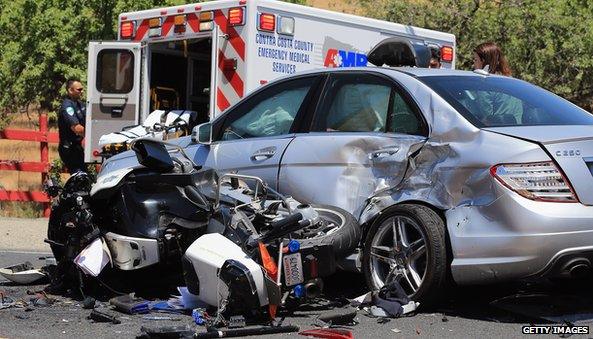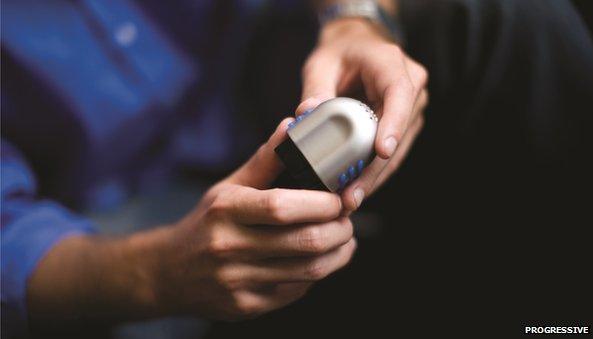How big data is changing the cost of insurance
- Published

Car insurers want to monitor driver behaviour to help them lower rates - and help improve customer driving
Dave Pratt winced when his teenage son bought himself a Jeep, thinking of how high the insurance would be on a young driver with a flashy car.
But unlike most parents, Mr Pratt is at the forefront of the insurance industry's efforts to change the way car insurance is priced.
So Mr Pratt, who works for insurer Progressive, installed the company's Snapshot device in his son's car.
It's what's known in the business as a "telematic" device, which monitors the speed his son drives every second and what time of day he drives. The device also beeps three times when his son brakes too suddenly.
When his son accused him of trying to train him to be a better driver, Mr Pratt agreed that was what he was trying to do.
This, he says, is the future of car insurance: being able to monitor individual drivers to give them lower prices but also to make them better drivers.
"Now that we can observe directly how people drive, we think this will change the way insurance works," says Mr Pratt, who adds that Progressive has more than a trillion seconds of driving data from 1.6 million customers.
"18 year old guys pay a lot for insurance, but some 18 year olds are really safe drivers and they deserve a better deal."
Sloppy business
Car insurance firms like Progressive in the US, to Tesco Bank in the UK and Generali Group in Italy, are currently in a race to convince consumers that letting them monitor their driving behaviour is actually a good thing.
This is because the technology, while not new, has only become affordable recently.
Also, consumers are just getting used to the idea of being tracking and having their data collected.

Progressive's Snapshot programme provides drivers with a small device that monitors driving speed
Proponents say this shift will reshape the insurance business.
"The way we've done insurance now compared to what we can do is sloppy," says Mike Fitzgerald, senior analyst at Celent, a research firm.
"We're taking tens of thousands of people and saying they all have the same risk profile when in fact they don't.
"Most people are actually overpaying."
This is because traditional insurance looks at averages, as opposed to specifics. You fill out a form saying you're a certain age, and drive a certain type of car, and are a specific gender - and that's basically all the data car companies have to assess your riskiness as driver.
Better big data technologies, like the telematic driving data collected by car companies or even information gathered from social media profiles, can help augment that risk profile.
"If I'm a driver that doesn't drive that frequently, and I have a pattern that would indicate that I drive more carefully than an average person with my profile, then I may be able to save 30-40% on my car insurance, and that's pretty significant," explains Joe Reifel, a partner at A.T. Kearney, a consulting firm.
Social life insurance
It's not just car insurers who want better data on consumers.
Jamie Yoder, head of Pricewaterhouse Cooper's insurance advisory practice, recently wrote a report, external looking at how sensors - like those used to help monitor workouts - could be used by life insurers looking to evaluate customer health.
And of course, there are the tweets.
"Every insurer we have spoken to has a team that looks at social media. The tools are rudimentary, but the data is being used," says Craig Beattie, also of Celent and an author of a report, external looking at social media use among insurers.
The challenge is being able to automate those teams, instead of using up precious manpower.
"They're sat on a great deal of opportunity with data but they can't get to it," says Mr Beattie.
Denied benefits for smiling
Of course, there is also the danger of misinterpreting that data.
Nathalie Blanchard offers one cautionary tale.
In 2009, while on leave from her technology job in Bromot, Quebec due to severe depression, she went to the bank one day only to find out her health insurance benefits had been cut off.
The cause? A few Facebook photos in which she was smiling.
The insurance company "determined unilaterally that based upon what they saw on the site, they didn't think that she was disabled and they cut her off," says her lawyer, Thomas Lavin. The case later settled out of court.
Anita Ramasastry, a law professor at the University of Washington, cautions regulations will need to be instituted to make sure that insurers don't overstep into big brother territory.
She asks: "are disclosures being made in a way that consumers understand how their social media information is being used for insurance scoring purposes and is there a way for the consumer to do anything about that?"
Fundamental shift
For now, using big data analytics for insurers is still in the early stages.
Only 2% of the US car insurance market offers an insurance product based on monitoring driving, according to A.T. Kearney's Mr Reifel, external.
But that proportion is projected to grow to around 10-15% of the market by 2017. And other countries, like Italy and the UK, are already using the data to analyse not just risk profiles but also to determine who is at fault in car accidents.
The future, most analysts agree, is to create a continuous feedback loop between insurers and consumers, so that consumers will react to the big data analyses that insurers do on them and change their behaviour accordingly.
"That's the end game - insurers could not just cover losses if they occur, but actually prevent them," says Mr Beattie.